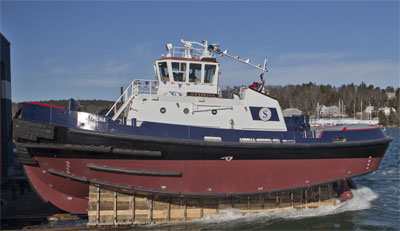Seabulk Towing has expanded its fleet with the addition of two new escort tugs from Washburn & Doughty Associates in Maine. The first, Athena, was launched in March. Its near twin, Apollo, is scheduled for launch in August.
According to Seabulk Towing Vice President Tom Denning, the new ASD tugs’ primary mission will be escorting and docking large ships. They will also have the ability to engage in conventional stern towing operations. Denning said that while Athena has yet to be assigned, it would likely serve in the Southeast or Gulf of Mexico. Denning noted that the ability to tow a large vessel in distress and fight fires is an example of the tugs’ versatility.
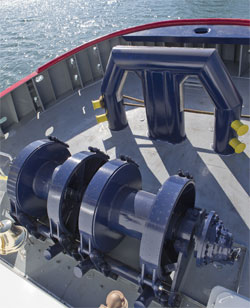 |
|
The JonRie model 220 double-drum bow winch with a tension-control feature. |
Both tugs were designed by Bruce Washburn, one of the yard’s founders. Athena is the first tug to be built by Washburn & Doughty for Seabulk Towing, a Seacor Holdings company.
Athena is 93 feet overall, with a beam of 38 feet and a maximum draft of 17 feet. As is typical of most asymmetrical stern-drive escort/docking tugs, Athena has a blunt bow for direct pushing and substantial beam that increases stability, especially during indirect towing maneuvers.
“Because of draft restrictions, we were able to increase the beam which also increased stability and resulted in a stiffer boat,” Washburn said. “The down side of the blunt bow is that the boat is less seakindly.”
Athena’s hull design also incorporates a box-like skeg that is built with a “window” which essentially extends the keel aft of midships. The design not only enhances maneuverability and lateral stability by creating more outward force when the tug is operating in escort mode, it also helps support the stern during dry-docking and serves as a reservoir for 2,000 gallons of generator coolant.
Another unique feature is the addition of an underwater fendering system used when docking submarines. All the D fendering on the deck edge and the upper cylindrical fenders are from Morse Rubber. The middle bow fender is 16-inch soft loop from Viking Fender and the lower bow fender is a laminated fender, also from Viking.
For propulsion Seabulk chose twin Caterpillar 3516B marine diesels with a rating of 2,682 bhp at 1,600 rpm. Compared with similar-sized power plants, the overall footprint of the Caterpillar engines is smaller, resulting in greater accessibility when servicing them and conserving precious engine room space. The engines drive nibral propellers through Schottel z-drives that are housed in an equally spacious machinery space aft. The tug’s speed is expected to be 13.5 knots.
For auxiliary power there are two John Deere 6068TFM76 99-kW gensets.
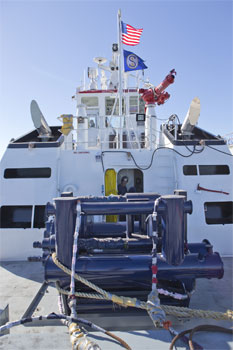 |
|
The towing winch is a single-drum JonRie model 512. |
The tug’s versatility is also evident in its deck layout, equipment choices and firefighting capability. For a forward hawser winch, Seabulk chose to install a JonRie model 220 high performance double-drum winch with an optional automatic tension-control feature. Each drum carries 450 feet of seven-inch line. The line pull is 14 short tons at 75 feet per minute and the braking capacity is 17 short tons. The aft towing winch is a single-drum JonRie model 512. It carries 2,100 feet of 2.25-inch wire rope and has a line pull of 45 short tons at 30 feet per minute and braking capacity of 142 short tons. Both winches are hydraulically operated.
From the forward winch the hawser is led through a reinforced steel A-shaped towing eye that is built into the cap rail. Aft, the towing wire is led from the tow winch through a Smith Berger towing pin on the transom. The two winches give the tug the flexibility to easily switch from escort/docking to direct towing mode. Bollard pull for the vessel is approximately 68 metric tons.
Off-ship firefighting is an important feature of any escort tug. To that end Athena has been equipped and certified FiFi 1/2.
The upper deck is equipped with one remote control monitor from Fire Fighting Systems AS of Norway. The monitor has the capacity to deliver 1,200 cubic meters per hour and is run off pumps connected to the main engine. Athena also carries 3,000 gallons of firefighting foam.
 |
Athena’s wheelhouse has been designed to maximize visibility and reduce fatigue on the operator. Large pilothouse windows ensure the helm almost unobstructed visibility, which is critical to spatial awareness for navigation, as well as a good view of the deck fore and aft to ensure crew safety.
The helm seat is an H.O. Bostrom SeaPost Sierra Pilot model that is flanked by Schottel Copilot model controls.
Electronics in the pilothouse include twin Furuno FR8062 radars with open four-foot array antennas, with GPS, AIS and gyrocompass interface. There is a Simrad AP50 autopilot with a Simrad JD53 interface, Simrad SC50 satellite compass, Furuno GP150 SOLAS compliant GPS receiver, Furuno FCV585 color sounder, Furuno FAX408 weather fax, Young 05106 wind speed indicator, and a Furuno BR500 bridge watch alarm system. The tug is also equipped with a Bluebox voyage data recorder.
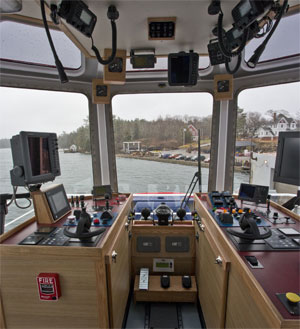 |
|
Pilothouse electronics include Furuno watch alarm system and radar with GPS, AIS and gyrocompass interface; and Simrad autopilot and satellite compass. |
Washburn & Doughty’s 93-foot design has been popular as a multi-mission tug thanks to its versatility. It has also caught the attention of crews who find the design spacious and comfortable. Every effort has been made to reduce noise and vibration through insulation and flooring materials. For climate control there is a Carrier air-conditioning system.
The tug’s broad beam has made it possible to expand all interior spaces and given flexibility to the configuration of staterooms and heads without compromising space in the galley and mess area. The galley is fully equipped for ease of meal preparation. The countertops, pantry and storage spaces are more than ample.
There is also a day head (no shower) in the deckhouse aft of the galley as you exit the fiddley going forward. The tug also features energy saving LED lighting and motion-sensing switches that turn off lights in heads and staterooms when they are not being used.
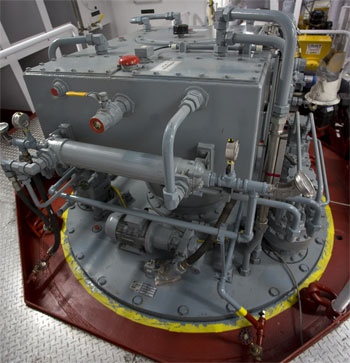 |
|
One of the tug’s twin Schottel z-drives. They are powered by Caterpillar 3516B marine diesels with a rating of 2,682 bhp each at 1,600 rpm. The tug is expected to have a top speed of 13.5 knots. |
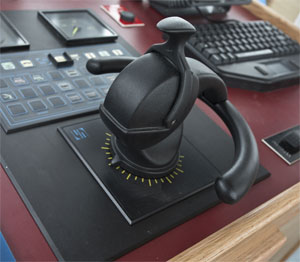 |
|
One of the z-drive controls in the pilothouse. |
Athena is operated by a crew of five and is configured with four staterooms, three heads and a total of six berths. The captain and engineer have private staterooms in the deckhouse to port, and share a common head and shower.
The lower deck has two staterooms separated by a shared head and shower. Two crewmembers share one stateroom, while the mate’s quarters are private. The passageway to the lower staterooms is fitted with gear lockers for additional storage.
Seabulk’s decision to build two almost identical tugs (they only differ in their FiFi classification and fendering) is testimony to the company’s confidence in Washburn’s proven design and the Maine yard’s quality workmanship.

